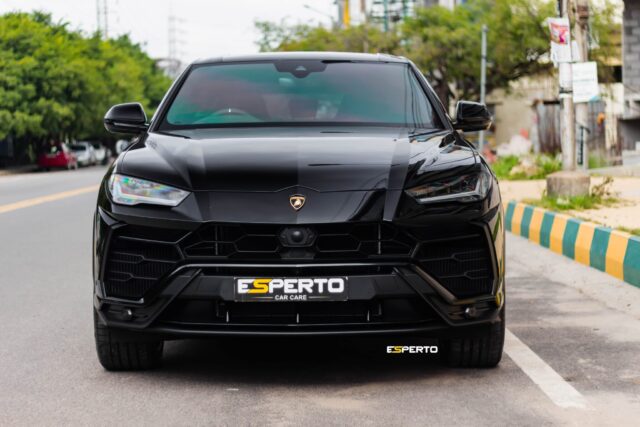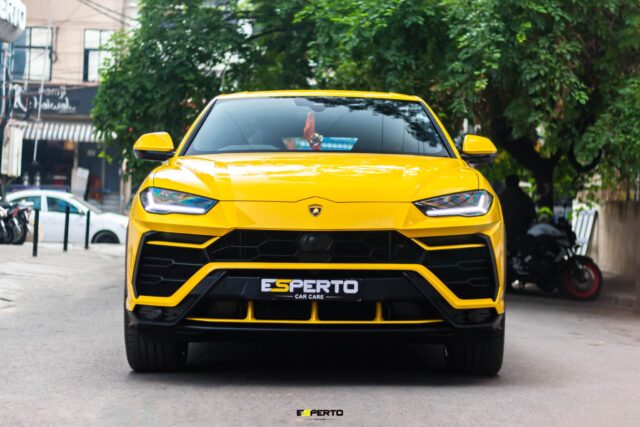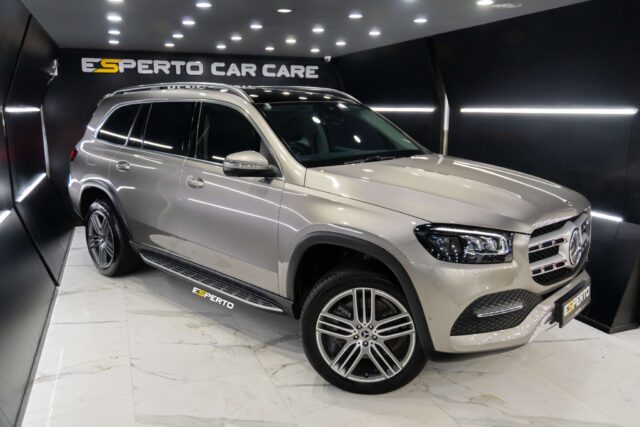Numerous vehicle owners aim to maintain their car’s paint to keep it shiny and as good as new. However, with time, tiny scratches caused by debris and exposure to severe weather can diminish that fresh, new appearance.
Instead of this problematic situation, consider the solution of Paint Protection Film (PPF), but understanding how to maintain clear paint film service for cars is essential to help your car’s shine last longer.
Paint Protection Film serves as a protector for your car’s paint, effectively defending it from damage caused by rocks, bugs, and minor scratches. Correct maintenance not only prolongs the film’s life but also ensures the continued optimal appearance of your car’s exterior.
This article will provide you with basic steps for routine care, methods to clean your car without damaging the PPF, and suggestions for combining PPF with ceramic coatings for extra protection.
Keep going through the article for significant knowledge on how to sustain your car’s glossy look.
What is Paint Protection Film, and Why is it Important?
Paint Protection Film (PPF) acts as a barrier for your car’s paint. It keeps the vehicle looking its best by guarding against scratches, chips, and stains from road debris and environmental contaminants.
Cars, bikes, and other vehicles face constant threats from rocks, bug splatter, bird droppings, and harsh weather. PPF offers an invisible protective layer that preserves your vehicle’s factory paint finish without altering its appearance.
Having PPF on your car is crucial because it maintains the car’s aesthetic appeal while boosting its resale value. The film’s durable material has self-healing properties that can repair minor scratches when exposed to heat.
This advancement in automotive care technology ensures your vehicle stays pristine for years to come. Installing a Paint Protection Film saves you money on costly repaint jobs and helps maintain your car’s cleanliness with less effort during regular commercial car washes.
Understanding Paint Protection Film
Paint Protection Film (PPF) serves as a guard to protect your car’s paint from harm caused by road debris, minor scratches, and sun exposure. This protective layer is a clear, durable film that adheres directly to the vehicle’s paint surface.
It maintains the quality and brilliance of your car’s paint, positioning it as a necessary investment for preserving your vehicle’s excellent appearance for an extended period.
PPF defends against environmental contaminants that can diminish your car’s look over time.
Implementing PPF helps sustain your car and paint’s exterior visual appeal and also helps preserve its resale value by hindering wear and tear on the vehicle’s exterior. Routine upkeep and proper attention ensure this film stays effective in warding off potential damage without modifying the original aesthetics of your car’s paint finish.
Benefits of PPF for Your Car
PPF, or paint protection film, offers your car unbeatable defense against scratches, stone chips, and environmental contaminants. Its self-healing technology can make minor scrapes disappear with heat from the sun or engine warmth.
This layer of protection ensures that your vehicle’s paint finish stays pristine longer without needing frequent touch-ups.
Maintaining your car’s PPF also means fewer visits to the detailer for paint repairs. It helps in preserving the car’s aesthetic appeal and resale value. Knowing that elements like road salt, bird droppings, and tree sap won’t immediately damage your vehicle’s exterior gives every car owner peace of mind.
With proper manual care for your car, the vehicle’s factory paint doesn’t degrade as fast over time due to these everyday occurrences.
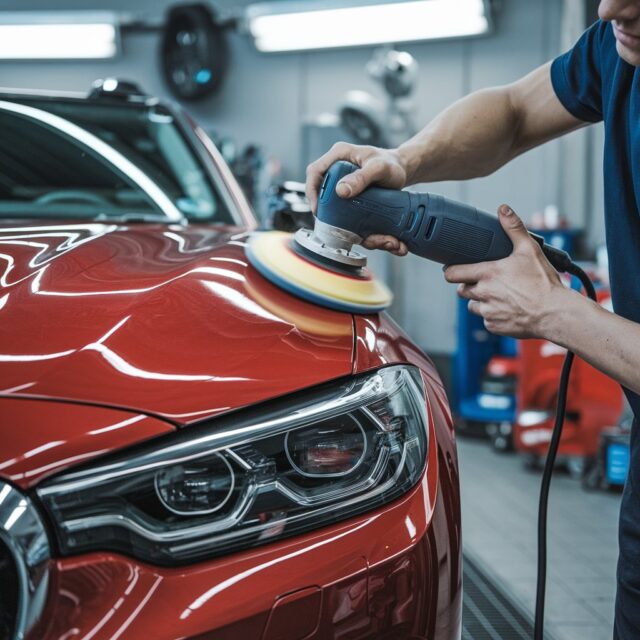
How PPF Protects Your Vehicle’s Paint
Building on the advantages of PPF, it’s crucial to understand how this protective film safeguards your vehicle’s paint finish. Paint Protection Film acts as a barrier between your car’s delicate paint and harsh environmental elements.
Rocks, road debris, and even bird droppings can cause significant damage to vehicle air over time. However, when PPF is applied, these potential threats don’t directly impact the vehicle’s surface.
This protection extends to less obvious dangers like UV radiation from the sun, which can fade and degrade paint colors swiftly. Moreover, the self-healing properties of many high-quality PPFs mean that minor scratches and swirl marks often disappear with exposure to heat from sunlight or engine warmth.
This keeps your car looking newer for longer by preserving its pristine condition against daily wear and tear.
How Do You Maintain Your Car’s PPF?
Maintaining your car’s paint protection film (PPF) ensures it continues to protect your vehicle’s paint from damage and keeps it looking its best. Start with regular maintenance, which involves cleaning the film gently but thoroughly.
Use a dedicated car wash soap and a clean microfiber wash mitt, and gently wash it to prevent scratches. Make sure you remove as much debris from the surface before washing to avoid dragging dirt across the PPF, which could potentially scratch the surface.
Avoid touching the film with any abrasive materials, and inspect your PPF for any signs of wear or lifting edges regularly. If you notice any issues, seek professional advice rather than trying to fix them yourself.
Protecting your vehicle with regular inspections and proper washing techniques will extend the life of both your car’s paint protection film and its overall appearance.
Regular maintenance is key to maximizing longevity.
Tips for Regular Maintenance
Regular maintenance of your car’s Paint Protection Film (PPF) keeps it looking new and ensures durability. Proper care prevents the film from damage and maintains your car’s shine.
- Regularly wash your vehicle to eliminate dirt and contaminants.Use a dedicated car wash product that is safe for PPF.
- Always use a clean microfiber cloth or wash mitt to clean the surface. This avoids scratches on your car’s paint.
- Avoid washing your car in direct sunlight. Heat can cause soap to dry quickly, leading to spots and streaks.
- Dry your vehicle with a soft, clean microfiber towel to prevent water spots.
- Inspect the PPF for any signs of lifting or peeling edges monthly. Address these issues early to prevent further damage.
- Apply a silicon dioxide (SiO2) based spray sealant every few months to enhance the film’s hydrophobic properties.
- Park your vehicle under cover or use a car cover when possible to protect against environmental damage like bird droppings and tree sap.
- Keep sharp objects away from the film to avoid punctures or tears.
- If you spot stains, such as bird droppings, clean them as soon as possible to avoid staining the film.
- Avoid using abrasive cleaners or brushes that can scratch the film during cleaning sessions.
Taking these steps will extend the life of your Paint Protection Film, keeping your car looking its best for years to come.
Using Proper Washing Techniques
Proper washing techniques keep your car’s paint protection film (PPF) in top condition. They ensure the long-lasting shine and protection of your vehicle’s exterior. Here are key steps to follow for effective cleaning:
- Rinse your car thoroughly with water to remove loose dirt and debris. This step prevents scratching during the wash.
- Use a high-quality car wash soap designed for vehicles with PPF. Generic or harsh soaps can damage the film.
- Apply the soap using a clean microfiber wash mitt. Microfiber is gentle on the film and helps avoid damaging it.
- Wash the vehicle section by section, starting from the top and working your way down to prevent dirt from moving to cleaner areas.
- Rinse each section after washing to prevent soap from drying on the surface, which can leave marks.
- Dry your car with a clean microfiber cloth or let it air dry if possible. Rough towels can scratch the film and car paint.
- Perform a regular maintenance schedule to check for any lifted edges or scratches in the film.
Following these steps helps maintain your PPF’s effectiveness in protecting against chips, scratches, and environmental contaminants, ensuring your vehicle continues to look its best while also preserving its value.
Avoiding Damage to the Film
Transitioning and discussing the appropriate techniques to care for your car’s paint protection film (PPF) is vital. Preserving the quality of your PPF aids in retaining the vehicle’s clean aesthetic and extends its strength and efficacy in shielding it from environmental contaminants.
- During cleaning, use a fresh microfiber cloth or wash mitt to avoid damaging the film. Dirt particles may cause harm to the surface similar to sandpaper.
- Refrain from using high-pressure water jets on the PPF edges. Intense pressure may elevate the film edges, resulting in peeling.
- Evade harsh chemicals or abrasive cleaners, which may degrade the film over time. A pH-neutral car wash soap for coated vehicles is a good alternative.
- Restrict exposure to direct sunlight for extended periods, as UV rays may induce discoloration and speed up the degradation of the film.
- Avoid automatic car washes with rigid brushes, which can create fine scratches and potentially peel off the PPF.
- In case of applying a ceramic coating over PPF, ensure its complete curing. Prematurely adding a coating may impact its adhesion and appearance.
- Treat any lifted areas or edges with care; avoid attempting to fix these issues manually, as it could intensify the problem.
- Inspect your PPF routinely for wear or damage signs, such as lifted corners, scratches, or texture changes, and engage professionals for repair.
- Keep objects with a sharp edge, like keys or tools, away from your vehicle’s exterior to prevent puncturing or tearing the film.
- For removal of difficult stains like bird droppings or tree sap, let them soak in warm soapy water before gentle removal.
Compliance with these methods aids in the effective maintenance of your vehicle’s paint protection film, securing lasting sheen and durability against daily damages and environmental stimuli.
What Are the Best Practices for Washing Your Car with PPF?
Keeping your car’s paint protection film (PPF) in top condition requires proper care. Washing your car the right way can extend the life of its PPF and keep the vehicle looking new.
- Use the right car wash soap: Select a soap designed for use on PPF to avoid damaging the film or reducing its lifespan.
- Pre-rinse your vehicle with clean water: This step removes loose dirt and debris, preventing scratches during washing.
- Apply soap with a clean microfiber wash mitt: Microfiber mitts are gentle on PPF and help avoid swirl marks or scratches.
- Wash from top to bottom: Dirt and grime are heavier toward the bottom of the vehicle, so start at the top to prevent spreading contaminants.
- Rinse thoroughly after washing: Leaving soap on the car can degrade PPF over time. Make sure you rinse off all soap residues.
- Dry with a clean microfiber cloth: Just like washing, drying should also be done gently to protect the film’s integrity.
- Avoid high-pressure washes directly on edges of PPF: High-pressure water can lift the film edges, causing it to peel.
- Park in the shade before starting: Extreme sun can cause water spots that are hard to remove and may damage PPF if left unattended.
Following these steps ensures that ceramic coating time your car’s protective film remains intact, keeping your paint shining bright for years to come.
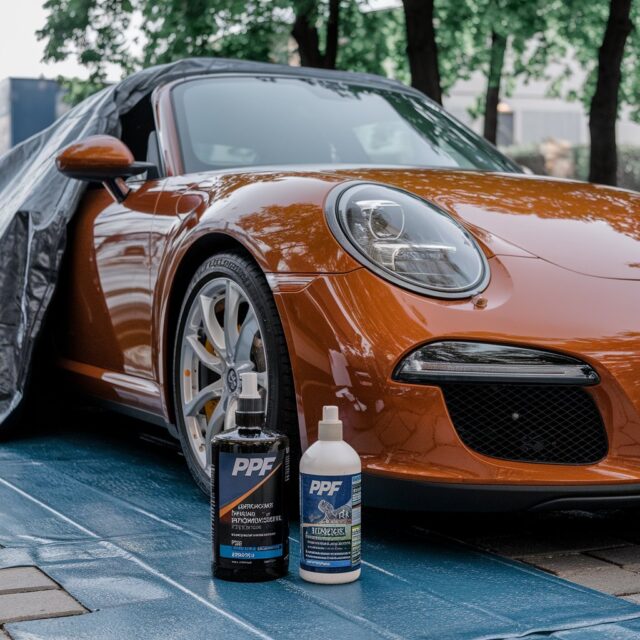
Choosing the Right Car Wash Soap
Selecting the right car wash soap is crucial for maintaining your vehicle’s paint protection film (PPF). You need a product that cleanly removes dirt without damaging the PPF. The best soaps are those specifically designed for cars with paint protection, as they gently lift away contaminants and provide a layer of protection to keep your paint looking new.
Using the wrong type can lead to deep scratches or dullness in your PPF, so choose wisely.
For an effective car wash solution, opt for soaps that advertise safe use on car PPF. These formulations will ensure that the curing process of your film remains intact while preserving its shine and durability.
Avoid harsh chemicals or abrasive materials found in some detergents, as these can compromise the protective qualities of your PPF. Instead, focus on pH-balanced options that cater to car care needs, ensuring a thorough wash without risking damage to your vehicle’s protective coating.
Using a Clean Microfiber Wash Mitt
Using a clean microfiber cloths wash mitt is crucial for maintaining your car’s paint protection film (PPF). A high-quality microfiber cloth mitt gently removes dirt and grime without scratching the film.
This ensures that your vehicle retains its shine and the protective film remains intact. Always make sure the wash mitt is free of debris before starting to wash your car, as trapped particles can cause scratches.
A proper wash technique with a microfiber mitt preserves both PPF and your car’s luster.
After washing, rinse the microfiber mitt thoroughly to remove any soap or dirt. This step prevents contaminants from staying in the fibers, which could be harmful in future uses. Keeping your wash mitt clean maximizes its lifespan and effectiveness, safeguarding your investment in paint protection for years to come.
Steps to Wash Your Car Safely
After ensuring your car is properly prepared with a clean microfiber wash mitt, the next critical step in vehicle air dry yourself involves washing your vehicle and drying your car manually and safely. This process helps maintain the integrity of your car paint protection film (PPF) and keeps your vehicle looking its best. Here are vital steps to follow for car air dry yourself:
- Choose a shaded area to wash your car. Direct sunlight can cause soap and water to dry quickly, leaving spots on the PPF.
- Rinse your car thoroughly with water before applying any soap. This step removes loose dirt and debris, preventing scratches during washing.
- Use a pH-neutral car wash soap designed for vehicles with PPF. These soaps ensure the film’s longevity by not degrading its adhesive or protective qualities.
- Use one bucket filled with soapy water and another with clean water to rinse your wash mitt, ensuring that dirt isn’t transferred back onto the car.
- Start washing from the top of your vehicle and work your way down. Gravity helps dirt flow downwards, making it easier to clean every section without redoing work.
- Wash each section of the car in straight lines rather than circular motions. Straight-line cleaning reduces the chance of creating swirl marks on the paint or PPF.
- After washing each section, rinse off the soap immediately with clean water to prevent drying that can lead to spots or streaks.
- Use a fresh, clean microfiber towel to dry your vehicle gently. Avoid letting it air dry, as this can also leave water spots on both the PPF and paint.
- Inspect the cleanliness of edges around PPF areas to ensure no soap residue is left behind, which can weaken adhesion over time.
10. Apply a silicon-based detailer spray as an additional protective layer if desired; these products are safe for use on PPF and enhance shine while repelling dirt and moisture.
Should You Consider Ceramic Coating Over PPF?
Ceramic coating offers an extra layer of protection for cars with paint protection film (PPF). This combination enhances your vehicle’s shine and shields it against environmental contaminants.
Ceramic coatings create a hydrophobic surface, making it easier to wash the and wash a car and maintain its look. They serve as a top coat over PPF, providing both gloss and additional safeguarding against elements like UV rays, acid rain, and bird droppings.
Deciding between ceramic coating or just PPF depends on what you need for your vehicle. If you want maximum protection plus ease of cleaning, applying ceramic on top of PPF might be the best choice.
Consider factors such as how often you use your vehicle, where you park it, and what environmental hazards it faces regularly. Combining PPF and ceramic gives your car the best treatment against wear while keeping maintenance easy.

Understanding Ceramic Coating
The ceramic coating acts as a hard shell over your car’s paint, protecting it from UV rays that can fade colours. This coat also makes cleaning easier by repelling water and preventing dirt from sticking to the car’s air or surface.
People often use ceramic coating for cars to keep them looking new without constant polishing and frequent washing.
A ceramic window shields your vehicle against environmental contaminants.
The curing process also involves applying a liquid polymer that bonds with the vehicle’s factory paint, creating a durable layer of protection. Many car owners choose this treatment for its ability to resist scratches and protect against chemical stains while enhancing the overall shine of their cars.
Unlike waxing, which needs frequent applications, a ceramic coat lasts for years with proper care.
Benefits of Combining PPF and Ceramic
The integration of Paint Protection Film (PPF) and Ceramic Coating offers vehicle owners optimum protection. PPF presents a solid physical shield against scratches, rock chips, and environmental factors.
Concurrently, Ceramic Coating offers an added layer of defense that repels water and dirt, simplifying your car washing process. This pair ensures your vehicle maintains its fresh appearance while simplifying upkeep tasks.
The ceramic’s increased shine pairs well with the PPF’s robust defense against everyday wear, providing you peace of mind.
This planned tactic secures your car’s paintwork under a protective layer that combats damage and keeps contaminants away. Utilizing correct washing techniques, automated car wash becomes even more efficient as dirt and debris smoothly roll off the ceramic surface.
Vehicle owners can appreciate their car’s appearance with less exertion while protecting against common road hazards.
With ongoing examination and upkeep, this layered technique prolongs your car’s visual allure and preserves its worth for a longer period.
Factors to Consider Before Coating
Choosing to add ceramic coatings over PPF brings several factors into play. First, weigh the cost against your budget. Ceramic coatings, while offering extra protection and shine, involve an additional expense.
You need to decide if this investment fits within your financial plan for car maintenance. Think about the age and condition of your vehicle, too. A newer car might benefit more from this dual layer of defense than an older model that already has wear or paint damage.
Consider how long you plan to keep your car as well. If you aim to sell it in a few years, the added value from both PPF and ceramic coating could make a difference in resale value.
For those who love keeping their vehicle looking its best, combining ppf maintenance with ceramic treatment means less frequent washes and easier upkeep. Always use proper washing techniques along with quality products designed for treated surfaces to maintain the film’s integrity and enhance its durability.
How to Extend the Longevity of Your Car’s Paint Protection Film?
Regular inspection and maintenance play a significant role in extending your car’s paint protective film’s life. You should inspect the paint correction film for any signs of wear or damage such as scratches or dents routinely.
If you find any, promptly address these issues to prevent further damage. Washing your vehicle regularly with a wash mitt or other soft wash media helps to immediately remove the dirt and contaminants that can wear down the film over time.
To safeguard your paint protection even more, ensure you’re protecting it against environmental contaminants. Park your car in shaded areas to avoid prolonged exposure to direct sunlight water, which can cause the film to discolor.
Also, applying wax designed explicitly for PPF can add an extra layer of protection, keeping the film glossy and new-looking. Finally, proper storage is crucial; if possible, store your vehicle in a garage to shield it from harsh weather conditions that could affect the film’s integrity.
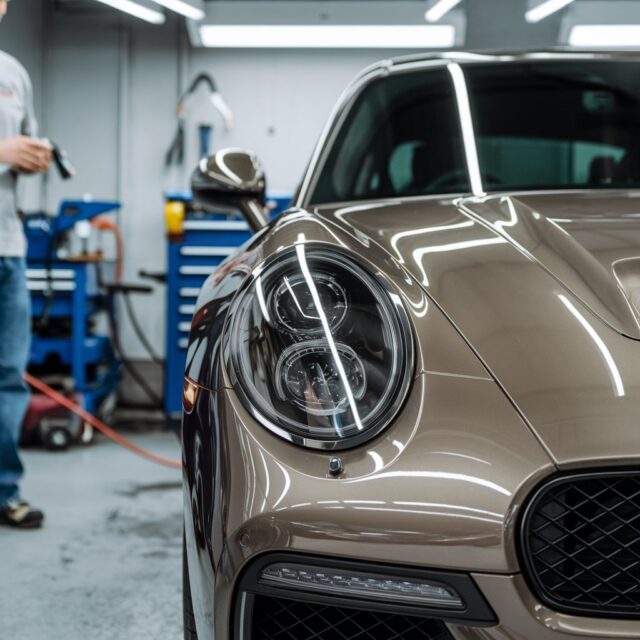
Regular Inspection and Maintenance
Keeping your car’s paint protection film (PPF) in top condition requires regular inspection and proper maintenance. This helps ensure the film for at least many years of service, providing that much-needed paint protection.
- Inspect the PPF monthly for any signs of lifting or peeling edges, which might allow dirt to accumulate beneath the surface.
- Wash a car with PPF every two weeks using car wash soap recommended for coated vehicles to avoid damaging the film.
- Apply gentle pressure with a clean microfiber cloth during washing to remove dirt without scratching the film.
- Look out for small scratches or marks, as PPF has self-healing properties that can be activated with heat.
- Use a clean microfiber wash mitt or other soft wash media to prevent harsh abrasives from coming into contact with the PPF.
- Avoid high-pressure washing directly on the film’s edges to prevent lifting or peeling.
- Store your vehicle in a garage or under a cover to protect against environmental contaminants like bird droppings and tree sap, which could damage the PPF over time.
- Keep sharp objects like keys away from the surface of the film to prevent punctures or cuts that can’t self-heal.
- Immediately clean off any stains, such as gasoline spills, oil, and other chemicals that could degrade the PPF if left unattended.
- Consider applying a ceramic coating over PPF for an extra layer of protection against contaminants while maintaining its shine.
Engaging in these practices will help extend the longevity of your vehicle’s paint protection, ensuring it remains looking its best while keeping maintenance needs low.
Protecting Against Environmental Contaminants
Protecting your car’s paint protection film (PPF) from environmental contaminants is essential for maintaining its shine and durability. These tips can help you shield your car with paint protection against various external elements that threaten the integrity of the car with paint protection.
- Wash your vehicle every two weeks using a clean microfiber cloth or wash mitt to prevent dirt buildup, which can scratch the PPF over time.
- Apply a safe, automotive-specific soap that doesn’t contain harsh chemicals, as these can degrade the film’s adhesive qualities.
- Park your car under cover whenever possible to avoid exposure to bird droppings and tree sap, which can etch into the PPF if left untreated.
- Use a soft cloth to gently wipe off any contaminants like bugs or tar as soon as you notice them on the film.
- Ensure proper maintenance of the film by regularly inspecting for signs of wear or damage, such as lifting edges or scratches.
- Avoid automatic car washes with stiff brushes, which can leave marks on the PPF; opt for touchless washes instead.
- Treat the PPF with a specialized sealant designed for paint protection films every few months to enhance its protective qualities against UV rays.
- Keep your vehicle away from industrial areas where increased levels of pollutants in the air could settle on the car’s surface, potentially harming the PPF.
These steps ensure that your car’s PPF remains intact and effective in protecting against scratches, chips, and environmental damages, keeping your vehicle looking newer for longer.
Proper Storage and Care for Your Vehicle
Proper storage and care for your vehicle safeguard the paint protection film (PPF) and ensure it keeps your car looking new. Maintaining your PPF requires regular attention to detail and a few maintenance tips.
- Park your vehicle in shaded areas or garages when not in use. This protects against harsh UV rays that can degrade the film over time.
- Use a soft cloth to clean the surface gently. Avoid using rough materials that might scratch the film.
- Ensure you wash your vehicle every two weeks, at least, to prevent dirt build-up which can damage the PPF.
- Apply a specialized PPF cleaner once a month to maintain its shine and protective properties.
- Inspect your PPF regularly for signs of wear or damage such as peeling or bubbling. This helps you catch issues early.
- Avoid placing magnetic signs or objects on the car’s surface, as they can leave marks on the film.
- Protect your car from chemical spills immediately by washing any harmful substances off quickly to avoid staining or damaging the PPF.
Next, let’s explore how regular inspection and maintenance contribute further to extending the longevity of your car’s PPF.
Conclusion
Keeping your car’s PPF in good condition ensures enduring luster and safeguarding. Basic steps such as consistent cleansing with suitable soap and employing a microfiber wash mitt can bring significant changes.
Have you thought about incorporating a ceramic coating for increased resilience? This pairing serves as an effective defense against scratches and environmental harm. For those keen on maintaining their vehicle’s prime look, inspecting the film frequently helps identify potential problems at an early stage.
If your car holds a special place in your heart, these straightforward measures will secure its attractive state for many years. Consider this: each step you take for maintenance contributes to your car’s excellent upkeep.



